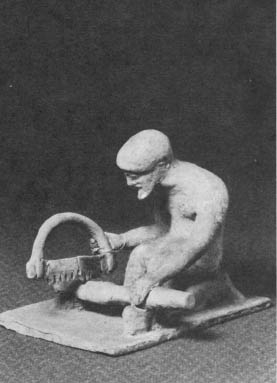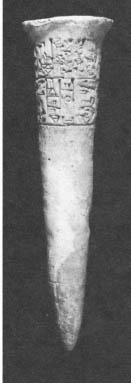The Ascent of Man (7 page)
Authors: Jacob Bronowski

Jericho is a microcosm of history. There will be other sites found in coming years (there are some important new ones already) which will change our picture
of the beginnings of civilisation. Yet the power of standing in this place, the vision backward along the ascent of modern man, is profound in thought and in emotion equally. When I was a young man, we all thought that mastery came from man’s domination of his physical environment. Now we have learned that real mastery comes from understanding and moulding the living environment. That is how man
began in the Fertile Crescent when he put his hand on plant and animal and, in learning to live with them, changed the world to his needs. When Kathleen Kenyon rediscovered the ancient tower in the 1950s, she found that it was hollow; and to me, this staircase is a sort of taproot, a peephole to the rock base of civilisation. And the rock base of civilisation is the living being, not the physical
world.
By 6000
BC
Jericho was a large agricultural settlement. Kathleen Kenyon estimates that it contained three thousand people, and covered eight or ten acres within the walls. The women ground the wheat with the heavy stone implements that characterise a settled community. The men shaped, patted and moulded the clay for building-bricks, some of the earliest known. The marks of the brick-makers’
thumbprints are still there. Man, like the bread wheat, is now fixed in his place. A settled community also has a different relation to the dead. The inhabitants of Jericho preserved some skulls and covered them with elaborate decoration. No one knows why, unless it was a reverential action.
No one who was brought up on the Old Testament, as I was, can leave Jericho without asking two questions:
Did Joshua finally destroy this city? And did the walls really come tumbling down? Those are the questions that bring people to this site and turn it into a living legend. To the first question, there is an easy answer: Yes. The tribes of Israel were fighting to get into the Fertile Crescent which runs up the Mediterranean coast, along the mountains of Anatolia, and down towards the Tigris and
Euphrates. And here at Jericho was the key that locked their way up the mountains of Judea and out into the Mediterranean fertile land. This they had to conquer, and they did about 1400
BC
– about three thousand three hundred to three thousand four hundred years ago. The Bible story was not written down until perhaps 700
BC
; that is, the account is about two thousand six hundred years old as a
written record.
But did the walls come tumbling down? We do not know. There is no archaeological evidence on this site that
suggests that a set of walls one fine day really fell flat. But many sets of walls did fall, at different times. There is a Bronze Age period here where a set of walls was rebuilt at least sixteen times. Because this is earthquake country. There are tremors here still every
day; there are four major quakes in a century. It is only in the last years that we have come to understand why earthquakes run along this valley. The Red Sea and the Dead Sea lie along a continuation of the Great Rift Valley of East Africa. Here two of the plates that carry the continents as they float on the denser mantle of the earth ride side by side. As they thrust past one another along
this rift, the surface of the earth echoes to the shocks that well up from below. As a result, earthquakes have always erupted along the axis on which the Dead Sea lies. And in my view that is why the Bible is full of memories of natural miracles: some ancient flood, some running dry of the Red Sea, the Jordan running dry, and the walls of Jericho falling down.
The Bible is a curious history,
part folklore and part record. History is, of course, written by the victors, and the Israelis, when they burst through here, became the carriers of history. The Bible is their story: the history of a people who had to stop being nomad and pastoral and had to become an agricultural tribe.
Farming and husbandry seem simple pursuits, but the Natufian sickle is a signal to show us that they do not
stand still. Every stage in the domestication of plant and animal life requires inventions, which begin as technical devices and from which flow scientific principles. The basic devices of the nimble-fingered mind lie about, unregarded, in any village anywhere in the world. Their cornucopia of small and subtle artifices is as ingenious, and in a deep sense as important in the ascent of man, as
any apparatus of nuclear physics: the needle, the awl, the pot, the brazier, the spade, the nail and the screw, the bellows, the string, the knot, the loom, the harness, the hook, the button, the shoe – one could name a hundred and not stop for breath. The richness comes from the interplay of inventions; a culture is a multiplier of ideas, in which each new device quickens and enlarges the power of
the rest.


 A cornucopia of small and subtle artifices as important in the ascent of man as any apparatus of nuclear physics.
A cornucopia of small and subtle artifices as important in the ascent of man as any apparatus of nuclear physics.Carpenter working on a piece of turned wood with a saw. Greek
, 6th century
BC
.
Clay treaty nail, Sumerian, 2400
BC
.
Baker’s oven with bread cooking. Clay model. Greek Islands, 7th century
BC
.
Settled agriculture creates a technology from which all physics, all science takes off. We
can see it in the change from the early sickle to the late. At first glance they look very much alike: the sickle of ten thousand years ago of the gatherer, and the sickle of nine thousand years ago when wheat was cultivated. But look more closely. The cultivated wheat is sawed with a serrated edge: because if you hit the wheat, then the grains will fall to the ground; but if you gently saw it, the
grains will be held in the ear of corn. And sickles have been made like this ever since then – into my boyhood in the First World War, when the curved sickle with the serrated edge was still what you cut wheat with. A technology like that, physical knowledge like that, comes to us out of every part of the agricultural life so spontaneously that we feel as if the ideas discover man, rather than
the other way about.
The most powerful invention in all agriculture is, of course, the plough. We think of the plough as a wedge dividing the soil. And the wedge is an important early mechanical invention. But the plough is also something much more fundamental: it is a lever which lifts the soil, and it is among the first applications of the principle of the lever. When, long afterwards, Archimedes
explained the theory of the lever to the Greeks, he said that with a fulcrum for the lever he could move the earth. But thousands of years before that the ploughmen of the Middle East had been saying ‘Give me a lever and I will feed the earth’.
I have remarked that agriculture was invented at least once again, much later, in America. But the plough and the wheel were not, because they depend
on the draught animal. The step beyond simple agriculture in the Middle East was the domestication of draught animals. The failure to make that biological move kept the New World back at the level of the digging stick and the pack; it did not even hit on the potter’s wheel.
The wheel is found for the first time before 3000
BC
in what is now southern Russia. These early finds are solid wooden
wheels attached to an older raft or sledge for drawing loads, which thereby is converted into a cart. From then on the wheel and axle becomes the double root from which invention grows. For example, it is turned into an instrument for grinding wheat – and using the forces of nature to do that: the animal forces first, and later the forces of wind and water. The wheel becomes a model for all motions
of rotation, a norm of explanation and a heavenly symbol of more than human power in science and in art alike. The sun is a wheeled chariot, and the sky itself is a wheel, from the time that the Babylonians and the Greeks mapped the turning of the starry heavens. In modern science natural motion (that is, undisturbed motion) goes in a straight line; but for Greek science, the form of motion that
seemed natural (that is, inherent in nature) and in fact perfect was motion in a circle.
About the time that Joshua stormed Jericho, say 1400
BC
, the mechanical engineers of Sumer and Assyria turned the wheel into a pulley to draw water. At the same time they designed large-scale irrigation systems. The vertical maintenance shafts still survive like punctuation marks across the Persian landscape.
They go down three hundred feet to the qanats or underground canals that make up the system, at a level where the natural water is
safe from evaporation. Three thousand years after they were made, the village women of Khuzistan still draw their water ration from the qanats to carry on the everyday chores of ancient communities.
 The bow-lathe is one of the classical schemes for turning linear into rotary motion.
The bow-lathe is one of the classical schemes for turning linear into rotary motion.Mid 19th-century carpenters at work with a bow-lathe, Central India
.
The qanats are a late construction of a city civilisation, and they imply the existence by then of laws to govern water rights and land tenure and other social relations. In an agricultural community (the large-scale peasant farming of Sinner,
for instance) the rule of law has a different character from the nomad law that governs the theft of a goat or a sheep. Now the social structure is bound up with the regulation of matters that affect the community as a whole: access to land, the upkeep and control of water rights, the right to use, turn and turn about, the precious constructions on which the harvest of the seasons depends.
By
now the village artisan has become an inventor in his own right. He combines the basic mechanical principles in sophisticated tools which are, in effect, early machines. They are traditional in the Middle East: the bow-lathe, for example, which is one of the classical schemes for turning linear into rotary motion. Here the scheme depends, ingeniously, on winding a string round a drum and fastening
the ends of the string to the two ends of a sort of violin bow. The piece of wood to be worked is fixed to the drum; it is turned by moving the bow to and fro, so that the string rotates the drum that holds the piece of wood, which is scored by a chisel. The combination is several thousand years old, but I saw it used by gipsies making chair-legs in a wood in England in 1945.